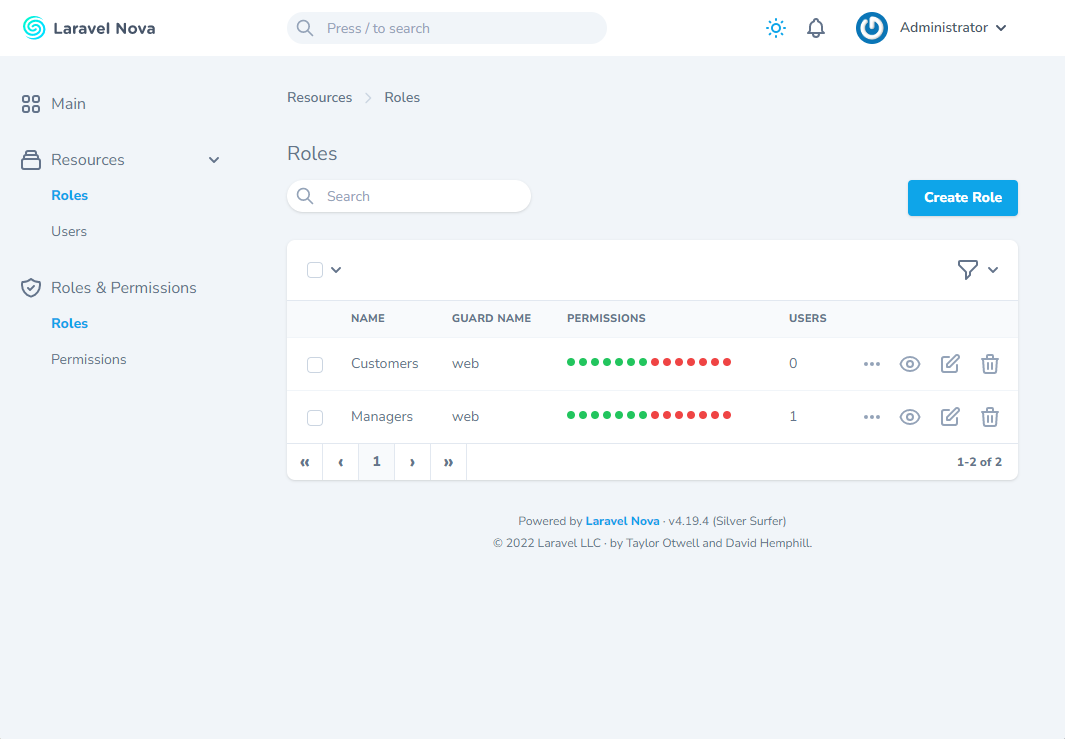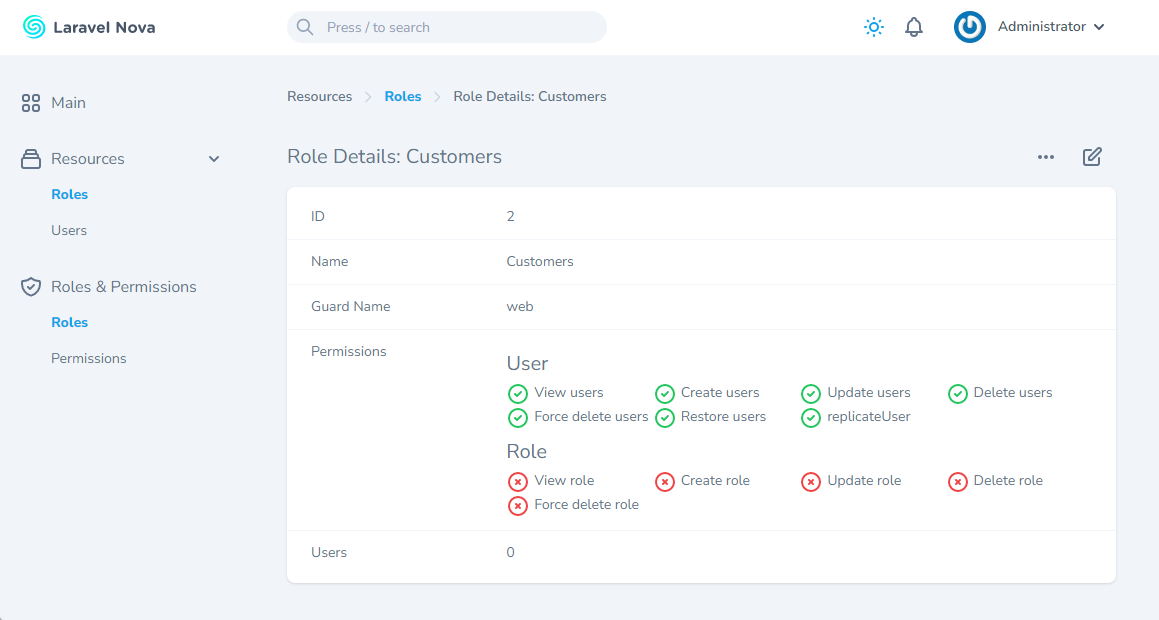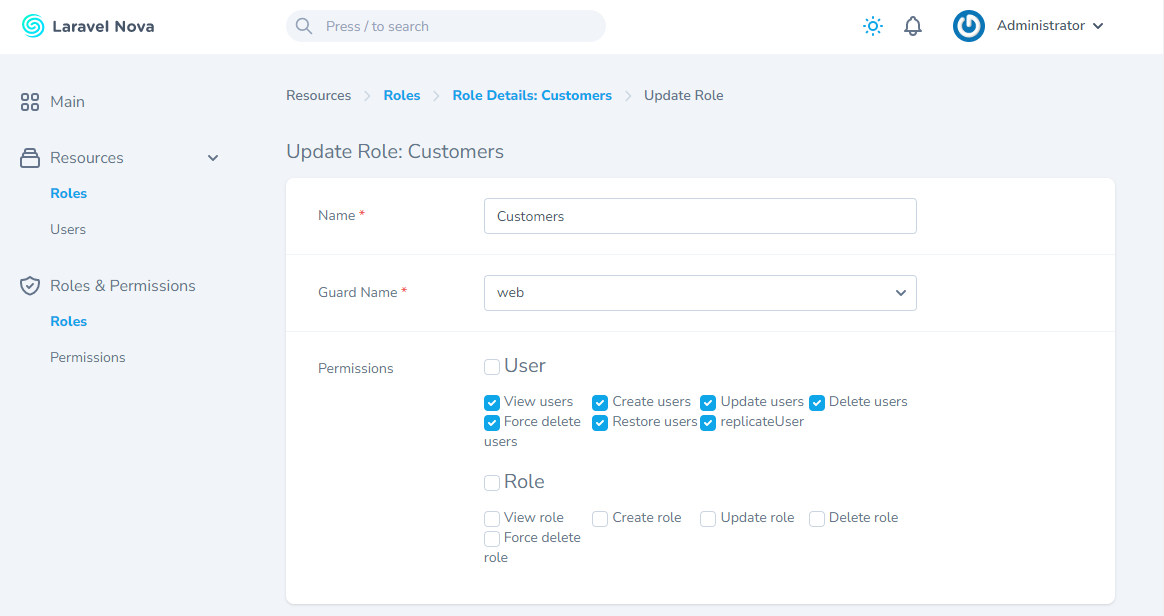sereny / nova-permissions
Laravel Nova - Roles & Permissions
Installs: 339 230
Dependents: 1
Suggesters: 0
Security: 0
Stars: 85
Watchers: 4
Forks: 34
pkg:composer/sereny/nova-permissions
Requires
- php: ^8.1
- laravel/nova: ^5.0
- spatie/laravel-permission: ^6.0
Requires (Dev)
- laravel/nova-devtool: ^1.2
README
A Laravel Nova Tool that allows you to group your Permissions and attach it to Users. It uses Spatie's laravel-permission.
We have a Migration, Seed, Policy and Resource ready for a good Authorization Experience.
Installation
You can install the package in to a Laravel app that uses Nova via composer:
composer require sereny/nova-permissions
Publish the Migration with the following command:
php artisan vendor:publish --provider="Sereny\NovaPermissions\ToolServiceProvider" --tag="migrations"
Migrate the Database:
php artisan migrate
Next up, you must register the tool with Nova. This is typically done in the tools method of the NovaServiceProvider.
// in app/Providers/NovaServiceProvider.php // ... public function tools() { return [ // ... new \Sereny\NovaPermissions\NovaPermissions(), ]; }
If you want to hide the tool from certain users, you can write your custom logic for the ability to see the tool:
// in app/Providers/NovaServiceProvider.php // ... public function tools() { return [ // ... (new \Sereny\NovaPermissions\NovaPermissions())->canSee(function ($request) { return $request->user()->isSuperAdmin(); }), ]; }
Finally, add MorphToMany fields to your app/Nova/User resource:
// ... use Laravel\Nova\Fields\MorphToMany; public function fields(Request $request) { return [ // ... MorphToMany::make('Roles', 'roles', \Sereny\NovaPermissions\Nova\Role::class), MorphToMany::make('Permissions', 'permissions', \Sereny\NovaPermissions\Nova\Permission::class), ]; }
Add the Spatie\Permission\Traits\HasRoles trait to your User model(s):
use Illuminate\Foundation\Auth\User as Authenticatable; use Spatie\Permission\Traits\HasRoles; class User extends Authenticatable { use HasRoles; // ... }
A new menu item called Roles & Permissions will appear in your Nova app after installing this package.
Permissions with Groups
Index View
Detail View
Edit View
Database Seeding
Publish our Seeder with the following command:
php artisan vendor:publish --provider="Sereny\NovaPermissions\ToolServiceProvider" --tag="seeders"
This is just an example on how you could seed your Database with Roles and Permissions. Modify RolesAndPermissionsSeeder.php in database/seeders. List all your Models you want to have Permissions for in the $collection Array and change the email for the Super-Admin:
<?php use Illuminate\Database\Seeder; use Spatie\Permission\Models\Role; use Spatie\Permission\Models\Permission; class RolesAndPermissionsSeeder extends Seeder { /** * Run the database seeds. * * @return void */ public function run() { // Reset cached roles and permissions app()[\Spatie\Permission\PermissionRegistrar::class]->forgetCachedPermissions(); $collection = collect([ 'Invoice', 'Client', 'Contact', 'Payment', 'Team', 'User', 'Role', 'Permission' // ... your own models/permission you want to crate ]); $collection->each(function ($item, $key) { // create permissions for each collection item Permission::create(['group' => $item, 'name' => 'viewAny' . $item]); Permission::create(['group' => $item, 'name' => 'view' . $item]); Permission::create(['group' => $item, 'name' => 'update' . $item]); Permission::create(['group' => $item, 'name' => 'create' . $item]); Permission::create(['group' => $item, 'name' => 'delete' . $item]); Permission::create(['group' => $item, 'name' => 'destroy' . $item]); }); // Create a Super-Admin Role and assign all permissions to it $role = Role::create(['name' => 'super-admin']); $role->givePermissionTo(Permission::all()); // Give User Super-Admin Role $user = \App\Models\User::where('email', 'your@email.com')->first(); // enter your email here $user->assignRole('super-admin'); } }
Now you can seed the Database. Add $this->call(RolesAndPermissionsSeeder::class); to the DatabaseSeeder.
Note: If this doesn't work, run
composer dumpautoloadto autoload the Seeder.
Create a Model Policy
You can extend Sereny\NovaPermissions\Policies\BasePolicy and have a very clean Model Policy that works with Nova.
For Example: Create a new Contact Policy with php artisan make:policy ContactPolicy with the following code:
<?php namespace App\Policies; use Sereny\NovaPermissions\Policies\BasePolicy; class ContactPolicy extends BasePolicy { /** * The Permission key the Policy corresponds to. * * @var string */ public $key = 'contact'; }
It should now work as exptected. Just create a Role, modify its Permissions and the Policy should take care of the rest.
Note: Don't forget to add your Policy to your
$policiesinApp\Providers\AuthServiceProvider.
Note: Only extend the Policy if you have created your Permissions according to our Seeding Example. Otherwise, make sure to have
viewAnyContact, viewContact, createContact, updateContact, deleteContact, restoreContact, destroyContactas Permissions in your Table in order to extend our Policy.
Super Admin
A Super Admin can do everything. If you extend our Policy, make sure to add a isSuperAdmin() Function to your App\User Model:
<?php namespace App; class User { /** * Determines if the User is a Super admin * @return null */ public function isSuperAdmin() { return $this->hasRole('super-admin'); } }
Customizations
// in app/Providers/NovaServiceProvider.php use App\Nova\Permission; use App\Nova\Role; use App\Policies\PermissionPolicy; use App\Policies\RolePolicy; // ... public function tools() { return [ // ... \Sereny\NovaPermissions\NovaPermissions::make() ->roleResource(Role::class) ->permissionResource(Permission::class) ->rolePolicy(RolePolicy::class) ->permissionPolicy(PermissionPolicy::class) ->disablePermissions() ->disableMenu(); ->hideFieldsFromRole([ 'id', 'guard_name' ]) ->hideFieldsFromPermission([ 'id', 'guard_name', 'users', 'roles' ]) ->resolveGuardsUsing(function($request) { return [ 'web' ]; }) ->resolveModelForGuardUsing(function($request) { /** @var App\Auth\CustomGuard $guard */ $guard = auth()->guard(); return $guard->getProvider()->getModel(); }) ]; }
Important
To customize the Role model you need to use Sereny\NovaPermissions\Traits\SupportsRole trait:
// Role using UUID primary key namespace App\Models; use Illuminate\Database\Eloquent\Concerns\HasUuids; use Illuminate\Support\Str; use Sereny\NovaPermissions\Traits\SupportsRole; use Spatie\Permission\Models\Role as BaseRole; class Role extends BaseRole { use HasUuids, SupportsRole; // REQUIRED TRAIT }
Credits
This Package is inspired by eminiarts/nova-permissions.
A huge thanks goes to Spatie spatie/laravel-permission for their amazing work!



